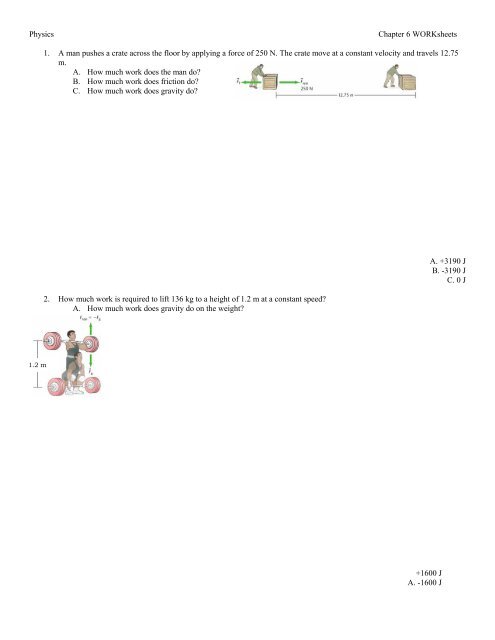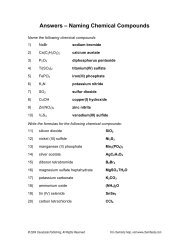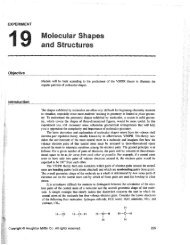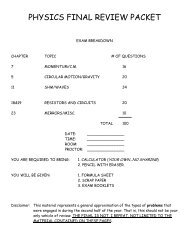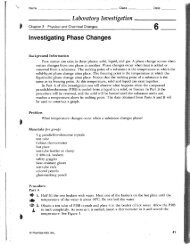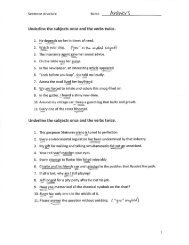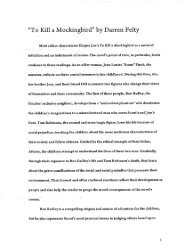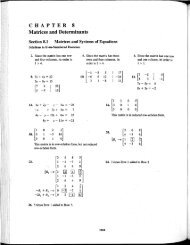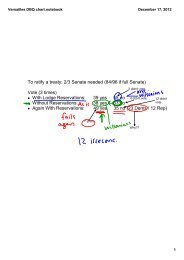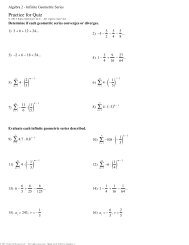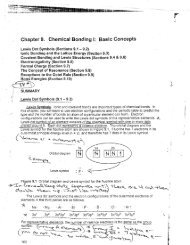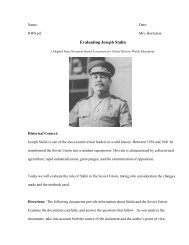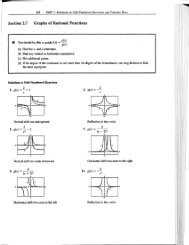Work and Energy Worksheets
Work and Energy Worksheets
Work and Energy Worksheets
Create successful ePaper yourself
Turn your PDF publications into a flip-book with our unique Google optimized e-Paper software.
Physics<br />
Chapter 6 WORKsheets<br />
1. A man pushes a crate across the floor by applying a force of 250 N. The crate move at a constant velocity <strong>and</strong> travels 12.75<br />
m.<br />
A. How much work does the man do?<br />
B. How much work does friction do?<br />
C. How much work does gravity do?<br />
2. How much work is required to lift 136 kg to a height of 1.2 m at a constant speed?<br />
A. How much work does gravity do on the weight?<br />
A. +3190 J<br />
B. -3190 J<br />
C. 0 J<br />
1.2 m<br />
+1600 J<br />
A. -1600 J
3. A force of 50.0 N is applied at an angle of 37° to a sled whose mass is 50.0 kg. The sled is pulled 8.0 m <strong>and</strong> the coefficient of<br />
friction is 0.07.<br />
A. How much work is done on the sled by the applied force?<br />
B. How much work is done on the sled by the friction force?<br />
C. What is the net work done on the sled?<br />
D. Will the sled speed up? Slow down? Travel with a constant velocity?<br />
A. +319. J<br />
B. –274 J<br />
C. +45 J<br />
D. Speed up<br />
4. A snickers bar contains 1,172,000 J (280 kcal) of energy. How many flights of stairs (each floor is 3.65 m) does a 84.0 kg<br />
person have to climb in order to “burn up” 1 snickers bar?<br />
390 flights
5. A student is out walking his dog. The dog sees a cat <strong>and</strong> begins dragging the 75.0 kg student with a force of 250.0 N across a<br />
frictionless field. The dog does 1375 J of work. How far does the dog drag the student?<br />
6. A force of 150.0 N is applied to a sled whose mass is 50.0 kg. The sled is pulled 8.0 m <strong>and</strong> the coefficient of friction is 0.10.<br />
A. How much work is done on the sled by the applied force?<br />
B. How much work is done on the sled by the friction force?<br />
C. What is the net work done on the sled?<br />
D. What is the work done by gravity on the sled?<br />
5.5 m<br />
A. +1200. J<br />
B. –392 J<br />
C. +808 J<br />
D. 0 J
7. Six books, each is 0.05 m thick <strong>and</strong> has a mass of 1.4 kg are lying flat on a table. How much work is required to stack them<br />
one on top of another?<br />
PHYSICS<br />
PHYSICS<br />
PHYSICS<br />
PHYSICS<br />
PHYSICS<br />
PHYSICS<br />
8. A 5.0 kg box is accelerated from rest across a frictionless floor at 2.0 m/s 2 for 5.0 seconds.<br />
A. How far will the box move?<br />
B. How much work was done on the box?<br />
10.3 J<br />
A. 25 m<br />
B. 250 J
9. The crate below is pulled a distance of 5.0 meters by the force P. If the floor is frictionless <strong>and</strong> the force does 1732 J of<br />
work, what is the angle θ?<br />
θ<br />
30°<br />
10. State whether the work done by force F in the following situations is (+positive, - negative, or 0 zero)<br />
moves<br />
F<br />
moves<br />
F<br />
moves<br />
F<br />
F<br />
moves<br />
F<br />
moves<br />
moves<br />
F
11. A force of 150.0 N is applied to a cart whose mass is 40.0 kg. The cart is pulled 10.0 m <strong>and</strong> the coefficient of friction is 0.20.<br />
A. How much work is done on the cart by the applied force?<br />
B. How much work is done on the cart by the friction force?<br />
C. What is the net work done on the cart?<br />
D. What is the work done by gravity on the cart?<br />
150 N<br />
12. How much work does gravity do on the 2 kg vase as it falls?<br />
A. +1500. J<br />
B. – 784 J<br />
C. + 716 J<br />
D. 0 J<br />
3 m<br />
[60 J]
13. While climbing Mt. Pioneer, Mr. McGeechan lifts his massively jacked 90 kg body up. In doing so he does 4,500 J of work.<br />
How high up did he climb?<br />
???<br />
14. Four books, each is 0.05 m thick <strong>and</strong> has a mass of 1.5 kg are lying flat on a table. Which book would require the most<br />
amount of work to stack? The least? How much work is required to stack them one on top of another?<br />
[5 m]<br />
[4.5 J]
15. Eight books, each with mass 1.7 kg, lie flat on a table. If it takes 20.1 J to stack the books, how thick is each book?<br />
[0.043 m]<br />
16. A 1300-N crate rests on the floor. How much work is required to move it at constant speed<br />
(a) 4.0 m along the floor against a friction force of 230 N, <strong>and</strong> [920 J]<br />
(b) 4.0 m vertically? [5200 J]
17. If the human body could convert a c<strong>and</strong>y bar directly into work how high could an 82-kg man climb a ladder if he were<br />
fueled by one bar (= 1100 kJ)?<br />
[1370 m]<br />
18. The coefficient of kinetic friction between a suitcase <strong>and</strong> the floor is 0.26. If the suitcase has a mass of 70.0 kg, how far can<br />
it be pushed across the level floor with 640 J of work?<br />
[3.6 m]
19. A water skier is being towed behind a boat. The boat does 10,000 J of work on the skier <strong>and</strong> the tension in the rope is 380 N.<br />
What angle does the rope make if the skier moves 30 m? [28.7°]<br />
θ<br />
30 m
20. A 64 kg student travels a height of 15 m.<br />
a. What amount of work is required? [9408 J]<br />
b. If the student produced 480 W of power, how long did the trip take? [19.6 s]<br />
21. If an engine does 1500 J of work in 2.0 minutes, what is its power in Watts? [12.5 W]
22. A motorized winch is rated at 10.0 kW. What maximum constant speed can this winch raise a mass of 27,500 kg? [0.037<br />
m/s]<br />
23. A 250 W motor must do a job that requires 145,000 J. How long will it take to do this job? [580 s]<br />
24. Playing basketball requires 800 W of power. How much work is done in 12 min of basketball? [576 kJ]
25. Sleeping requires 83 W of power. How long in hours would you have to sleep to burn 1,172,000 J of energy (1 Snickers<br />
bar)? [3.92 hours!]<br />
26. How much power is required to bench press 136 kg (300 lbs) to a height of 0.45 m if it takes 0.20 seconds to lift? [3000 W]<br />
27. A bulldozer pushes a rock with a force of 8500 N at 1.8 m/s for 35 s.<br />
a. How far does the rock travel? [63 m]<br />
b. How much work is done by the bulldozer? [535,500 J]<br />
c. How much power is required? [15,300 W]
<strong>Work</strong> <strong>and</strong> Graphing.<br />
SPRING GRAPHS (HOOKE’S LAW<br />
60<br />
50<br />
40<br />
Force (N)<br />
30<br />
20<br />
10<br />
0<br />
0 0.2 0.4 0.6 0.8 1 1.2 1.4<br />
Distance (m)<br />
28. What is the spring constant (k) of the spring?<br />
29. How much work is required to stretch the spring from 0 to 1.4 m?<br />
[40 N/m]<br />
[39.2 J]
90<br />
80<br />
70<br />
60<br />
Force (N)<br />
50<br />
40<br />
SPRING A<br />
30<br />
SPRING B<br />
20<br />
10<br />
SPRING C<br />
0<br />
0 0.1 0.2 0.3 0.4 0.5 0.6 0.7 0.8 0.9 1<br />
Distance (m)<br />
30. Rank the springs from largest to smallest spring constant.<br />
31. How much work is needed to stretch spring B from 0.5 m to 0.9 m?<br />
[10 J]
32. Given the following graph, determine the work done by the force.<br />
[24 J]<br />
33. Given the following graph, determine the work done by the force.<br />
[30 J]
KINETIC ENERGY<br />
Just Kinetic<br />
34. What is the kinetic energy of a 0.500 kg baseball traveling at 25.0 m/s?<br />
35. What will be the kinetic energy of the baseball in problem #34 if its velocity is tripled?<br />
[156 J]<br />
[1406 J]<br />
36. A 3.5 kg object has a kinetic energy of 2400 J. How fast is it traveling?<br />
[37 m/s]
37. 6500 J of kinetic energy is given to a ball. As a result it travels at 15 m/s. What is its mass?<br />
[58 kg]<br />
38. A 10 kg toy car is traveling at 4 m/s. It increases its velocity by 15%.<br />
A. What is its new velocity? [4.6 m/s]<br />
B. By how much (%) does its kinetic energy increase? [32%]
39. An 65 kg athlete on a trampoline leaps straight up into the air with an initial speed of 9.0 m/s. What is the kinetic energy?<br />
[2633 J]<br />
40. A 70-kg base runner begins his slide into second base when he is moving at a speed of 4.0 m/s. What is his kinetic energy?<br />
[560 J]<br />
41. A 7.00 kg bowling ball moves at 3.00 m/s. How fast must a 2.45 gram Ping-Pong ball move so that the two balls have the<br />
same kinetic energy<br />
[160 m/s]
42. A 0.60-kg particle has a speed of 2.0 m/s at point A <strong>and</strong> a kinetic energy of 7.5 J at point B. What is<br />
(a) its kinetic energy at A? [1.2 J]<br />
(b) its speed at point B? [5 m/s]<br />
43. What happens to the kinetic energy of an object if its velocity is tripled? Its mass is tripled? Its velocity is quadrupled?<br />
44. Can an object have negative kinetic energy? Explain…
45. A car going 5 m/s increases its velocity to 7 m/s. How much will its kinetic energy increase?<br />
46. A ball going 6 m/s has a kinetic energy of 450 J. What is the mass of the ball?<br />
[by 24 J]<br />
[25 kg]
Just Potential<br />
47. What is the potential energy of the 85 kg skier that is 5 m above the bottom of a hill?<br />
48. How high would a 3.9 kg ball have to be in order to have 345 J of potential energy?<br />
[4165 J]<br />
49. A rock on top of an 8 m tall hill has 380 J of potential energy. What must be the mass of the rock?<br />
[9 m]<br />
50. How much potential energy will a spring (k = 48 N/m) have if it is compressed 0.85 m?<br />
[4.85 kg]<br />
[17.3 J]
51. What is the spring constant of a spring that stores 1150 J on energy when it is compressed 75 cm?<br />
52. How far do you have to pull a spring (k = 125 N/m) in order for it to store 600 J of energy?<br />
[4089 N/m]<br />
[3.1 m]<br />
53. How much energy does a spring (k = 345 N/m) store if it is stretched 0.55 m? If all that energy were given to a 3.0 kg car<br />
what would its velocity be?<br />
[52.1 J, 5.9 m/s]
54. What is the potential energy of the 80 kg skier:<br />
(a) A t point A? [7840 J]<br />
(b) At point B? [0 J]<br />
(c) What is her kinetic energy at point B? [7840 J]<br />
55. The block is pushed up against the spring <strong>and</strong> is held at rest.<br />
A. How much PE does it have initially? [11.9 J]<br />
B. How much PE will it have when the spring lets go? [0 J]<br />
C. What is its KE initially? [0 J]<br />
D. What is its KE after the spring lets go? [11.9 J]<br />
E. How fast will it be traveling after the spring lets go? [3.4 m/s]<br />
k = 95 N/m<br />
0.5 m<br />
2 kg
56. What is the potential energy of the block in each situation:<br />
3 kg<br />
5 kg<br />
5 m<br />
10 m<br />
4 m<br />
40º<br />
[88.2 J]<br />
[315 J]<br />
4 kg<br />
7 m<br />
30º<br />
[158 J]
Conservation of <strong>Energy</strong><br />
WITH GRAVITY<br />
57. Fill in the blanks:<br />
v = 0<br />
60 kg<br />
PE:_____________<br />
KE:____________<br />
Tot. E:__________<br />
15 m<br />
PE:_____________<br />
KE:____________<br />
Tot. E:__________<br />
58. Fill in the blanks<br />
PE:_____________<br />
KE:____________<br />
Tot. E:__________<br />
60 kg v = 5 m/s<br />
20 m<br />
PE:_____________<br />
KE:____________<br />
Tot. E:__________
59. Fill in the blanks<br />
PE:_____________<br />
KE:____________<br />
v = 30 m/s<br />
Tot. E:__________<br />
3 kg<br />
PE:_____________<br />
KE:____________<br />
Tot. E:__________<br />
Velocity of sled at bottom in #57________Velocity of sled at bottom #58___________Velocity of rocket at top #59__________<br />
WITH SPRINGS<br />
60. Fill in the blanks<br />
k = 450 N/m<br />
3 kg<br />
PE:_____________<br />
KE:____________<br />
Tot. E:__________<br />
0.5 m<br />
3 kg<br />
PE:_____________<br />
KE:____________<br />
Tot. E:__________
61. You know the deal…. 10 kg<br />
v = 0<br />
PE:_____________<br />
k = 900 N/m<br />
(stops after hitting spring)<br />
4 m<br />
KE:____________<br />
Tot. E:__________<br />
PE:_____________<br />
KE:____________<br />
Tot. E:__________<br />
62. You know the deal…..<br />
PE:_____________<br />
v = 3 m/s<br />
m = 1 kg<br />
KE:____________<br />
Tot. E:__________<br />
d = 0.2 m<br />
PE:_____________<br />
KE:____________<br />
Tot. E:__________<br />
2 m<br />
Velocity of the block in #60_________Distance (d) spring compresses in #61___________Spring constant (k) in #62____________
63. What is the μ in the following situation? (Starts <strong>and</strong> ends at rest)<br />
[μ = 0.33]<br />
64. What will be the speed at B? At C? How far into the friction will it travel? hmm…no mass is given<br />
3 m/s<br />
11 m<br />
5 m<br />
μ = 0.45<br />
[v B = 15 m/s, v C = 11.3 m/s, d = 14.3 m]
65. By how much will the spring compress if μ = 0.15 on the level surface?<br />
1.5 m<br />
[0.83 m]<br />
For all problems….Snoopy’s mass is 55 kg<br />
66. How far will Snoop travel in the following situation?<br />
3 m<br />
v = 0<br />
?<br />
K = 1120 N/m μ = 0.55<br />
[17 m]
67. How high up the other side of the half pipe will Snoop go ?<br />
v 0 = 3 m/s<br />
12 m<br />
2.5 m<br />
h = ? [12 m]<br />
µ = 0.18<br />
How fast will Snoop be going after he exits the rough surface?<br />
[15.3 m/s]<br />
How far from the stop sign will he come to rest (no energy)?<br />
[0.78 m]
68. The 10 kg block is released from rest at point A. There is only friction between points B <strong>and</strong> C. The block hits the spring <strong>and</strong><br />
causes it to compress 0.30 m.<br />
A. What is the coefficient of friction between B <strong>and</strong> C?<br />
B. How far from point B will the block come to rest with no energy?<br />
k = 2,250 N/m<br />
[A. μ = 0.33]<br />
[B. 2.9 m]


